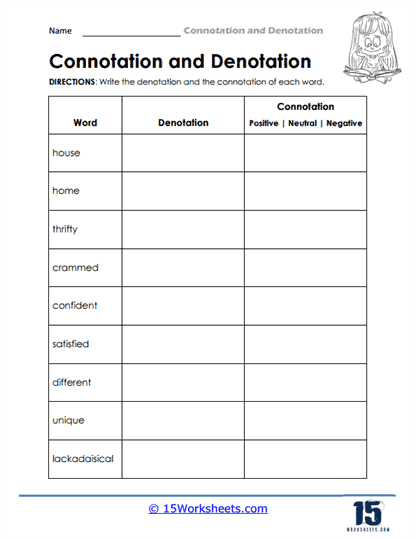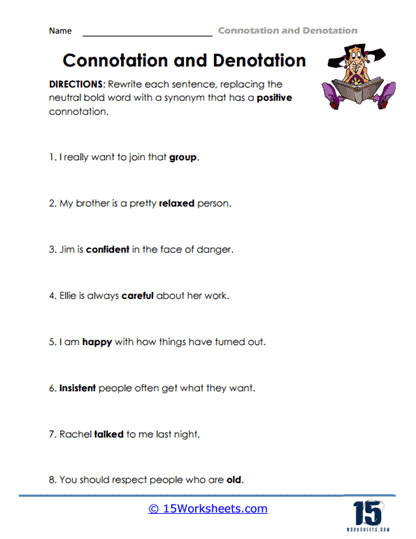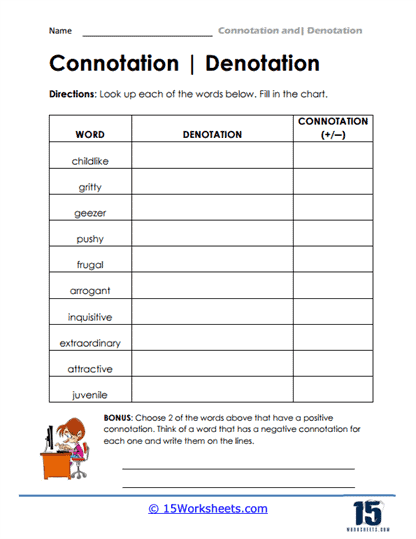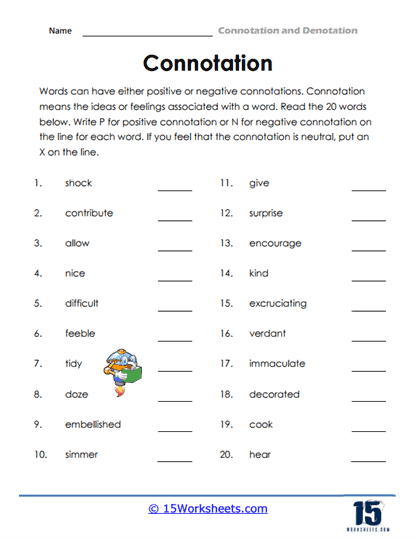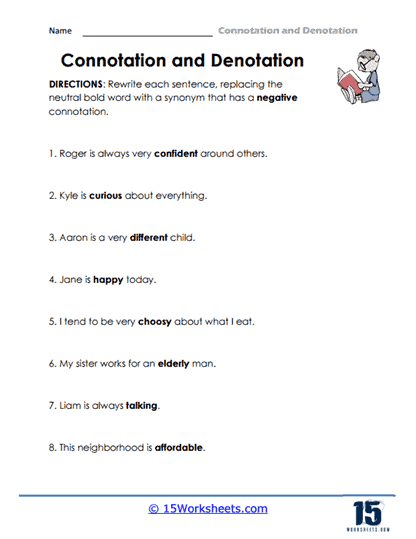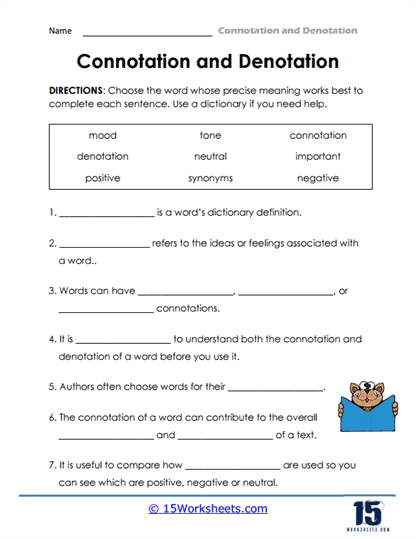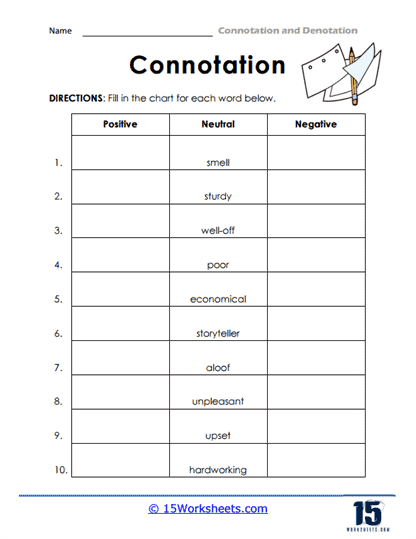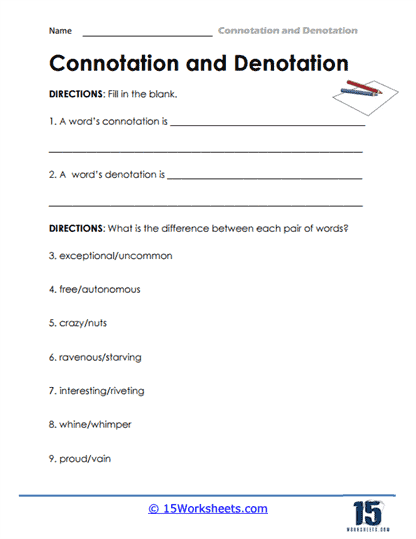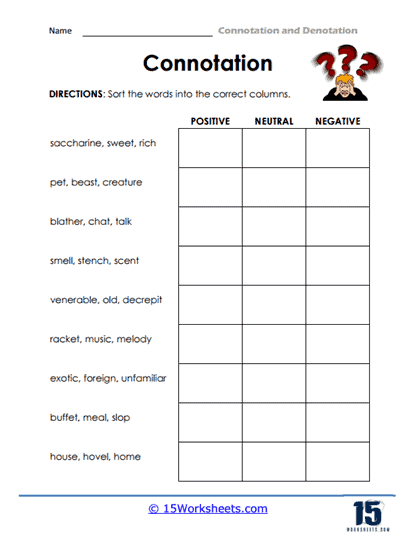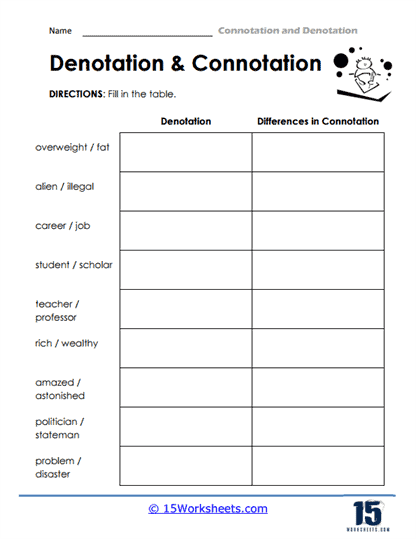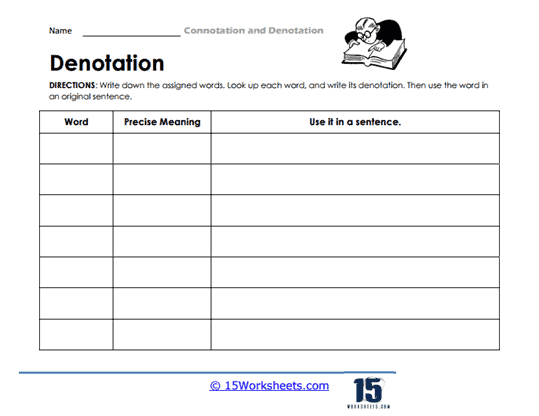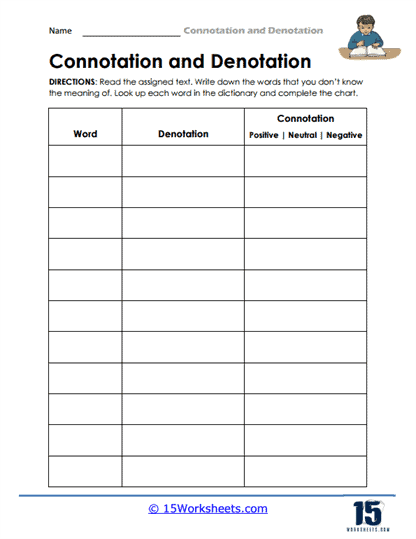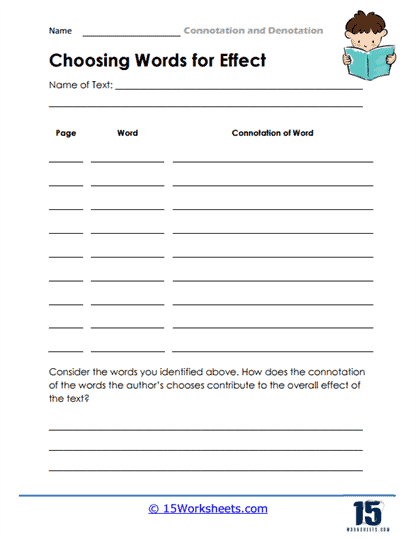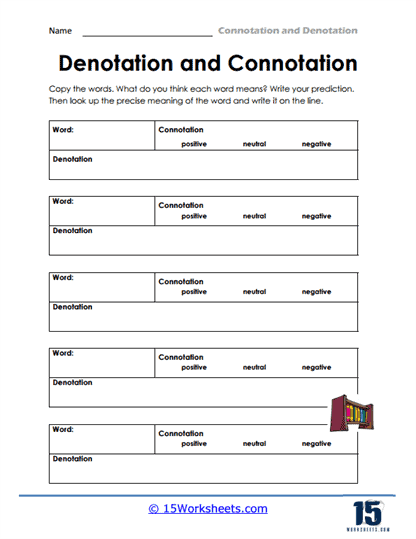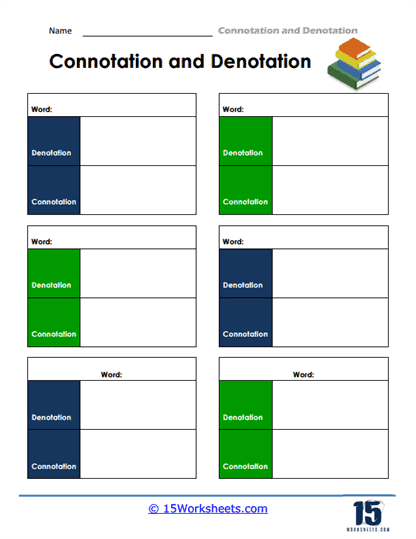Connotation and Denotation Worksheets
All About These 15 Worksheets
Language is a powerful tool that extends beyond its literal meanings, shaping perceptions and evoking emotions. This collection of 15 worksheets on Connotation and Denotation embarks on an illuminating journey through the intricacies of language.
We begin with “Word Vibes,” a worksheet that encourages students to feel the emotional resonance of words. It’s like a mood ring for vocabulary-does “home” feel warm and fuzzy, or does it echo with the chill of obligation? “From Basic To Elevated” then challenges students to swap out mundane words for their more sophisticated cousins, turning “happy” into “elated” and “sad” into “melancholy,” proving that a thesaurus can be a student’s best friend-or at least a charming acquaintance.
“Charting Quest” and “Positive, Negative, Or Neutral?” transform students into cartographers of connotation, mapping out the emotional terrain of language. Is “slim” a compliment or a critique? Does “cheap” imply frugality or poor quality? These worksheets are less about right or wrong and more about understanding the power of context-a lesson as valuable in life as it is in language.
“Negate The Neutrals” and “Choose The Perfect Fit” are the fashionistas of the worksheet world, urging students to dress their sentences in the most appropriate attire. Just as one wouldn’t wear flip-flops to a formal gala, one shouldn’t pair “lavish” with a description of a modest meal. Meanwhile, “Figuring Out Counterparts” and “Grasping Language Nuances” delve deeper, exploring how synonyms can carry vastly different implications, much like how “assertive” and “pushy” can describe the same behavior through different lenses.
The adventure continues with “Categorization Challenge” and “Contrasting Pairs,” where students sort words like laundry-separating the whites from the colors, the positives from the negatives. “Use It In A Sentence” and “Vocabulary Expansion” then encourage students to take their freshly laundered words and put them to use, crafting sentences that showcase their understanding of subtle differences in meaning.
Finally, “Textual Dynamics,” “Predict, Define, And Decode,” and “Connotation-Denotation Duo” serve as the capstone projects, challenging students to apply their skills in more complex contexts. These worksheets are the final exams of the connotation and denotation curriculum, testing students’ abilities to navigate the intricate dance of language with grace and precision.
In sum, this collection is more than just a series of worksheets; it’s a journey through the rich tapestry of language. It’s where students learn that words are not just tools for communication but instruments of persuasion, emotion, and artistry. So, sharpen those pencils and prepare to waltz through the world of words-just watch out for the occasional linguistic landmine.
Importance of Connotation and Denotation: The Language’s Palette
The interplay between connotation and denotation influences how we perceive and respond to language. An understanding of these nuances fosters effective communication, aids in literary analysis, and enhances language proficiency.
This collection of worksheets underscores the pivotal role that connotation and denotation play in both written and spoken communication. By engaging with these worksheets, students not only become adept at decoding and employing subtle meanings but also develop critical thinking skills that empower them to navigate the complexities of language.
What are Connotations and Denotations?
Connotations and denotations are two important terms that are used in English literature. They are often confused with each other, but there is a big difference between the two.
What are Connotations?
An image or emotion that a word conjures up in literature in addition to its literal or primary meaning is known as a connotation.
Connotations can be positive, negative, or neutral. Words with positive connotations evoke pleasant emotions and may prompt favorable thoughts or feelings about the thing being described, while words with negative connotations elicit unfavorable emotions and may prompt unpleasant thoughts or feelings about the thing being described. Moreover, words with neutral connotations neither evoke particularly positive nor negative emotions.
Many common words have strong connotations. For example, the word “home” has positive connotations of comfort and safety, while the word “prison” has strong negative connotations of confinement and punishment.
Also consider the words “home” and “house.” Both words refer to a residential dwelling, but their connotations are different:
“House” has a neutral connotation, as it simply denotes a physical building meant for human habitation.
“Home,” on the other hand, has a positive connotation, as it often evokes feelings of warmth, comfort, safety, and familiarity.
The word “home” implies not just a physical structure, but also the emotional and personal connections that people have with the place where they live or grew up. In this example, the connotation adds an emotional layer to the word’s meaning that goes beyond its literal definition.
The writer’s choice of words can heavily influence the tone of a piece of writing with particular connotations. By carefully selecting words with the desired connotations, a writer can create a certain mood or atmosphere in their writing.
What are Denotations?
In English literature, denotations are the literal dictionary definitions of words. However, these definitions often fail to capture the true meanings of words, as they can be influenced by a person’s experiences and cultural context.
For example, the word “home” can have very different connotations for someone who grew up in a stable, loving family and someone who experienced abuse and neglect. As a result, it is important to consider both the denotations and connotations of words when analyzing a text.
We can also consider the word “snake.” The denotation of “snake” is a long, legless, carnivorous reptile with a flexible body, covered in scales, and belonging to the suborder Serpentes.
In this case, the denotation of “snake” provides a straightforward, objective description of the reptile without considering any emotional associations, such as fear or fascination, that people might have with snakes.
By understanding the multiple levels of meaning in a text, readers can better understand the author’s intent.
One of the most important aspects of writing is choosing the right words to convey your meaning. Not all words are created equal, and understanding the difference between connotations and denotations can help you make more informed choices about the language you use in your writing.
Here are three things to keep in mind:
1. The context in which a word is used can change its connotation. For instance, if someone says they are going “home” to their family, the connotation is likely to be more positive than if they say they are going “home” to their empty house.
2. Pay attention to the connotations of words when choosing them for your writing. Some words might carry positive or negative connotations that you weren’t aware of, and that could influence how your readers perceive your work.
3. Be aware that the connotations of words can change over time. What might have been a positive word centuries ago might now have negative connotations and vice versa. Keeping up with these changes can help you avoid using outdated or offensive language.
This compilation of 15 worksheets on Connotation and Denotation transcends being a mere educational resource; it’s a portal to mastering the subtleties of language.
By diving into the worlds of connotation and denotation, students emerge as astute communicators, capable of wielding language’s nuances to convey complex emotions, ideas, and arguments.
These worksheets not only enrich language proficiency but also nurture critical thinking, empathy, and cultural awareness. Armed with the ability to discern and employ connotations effectively, students navigate language’s dynamic landscape with finesse, connecting more deeply with others and expressing themselves with authenticity and impact.

